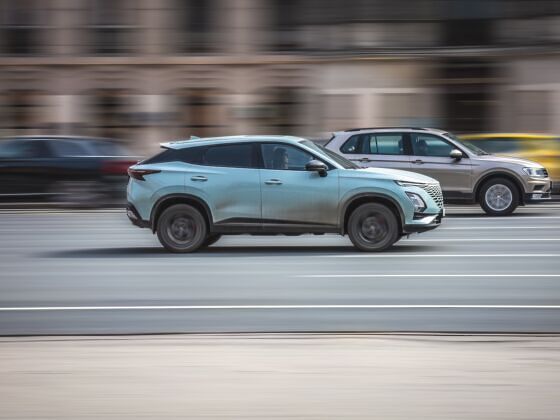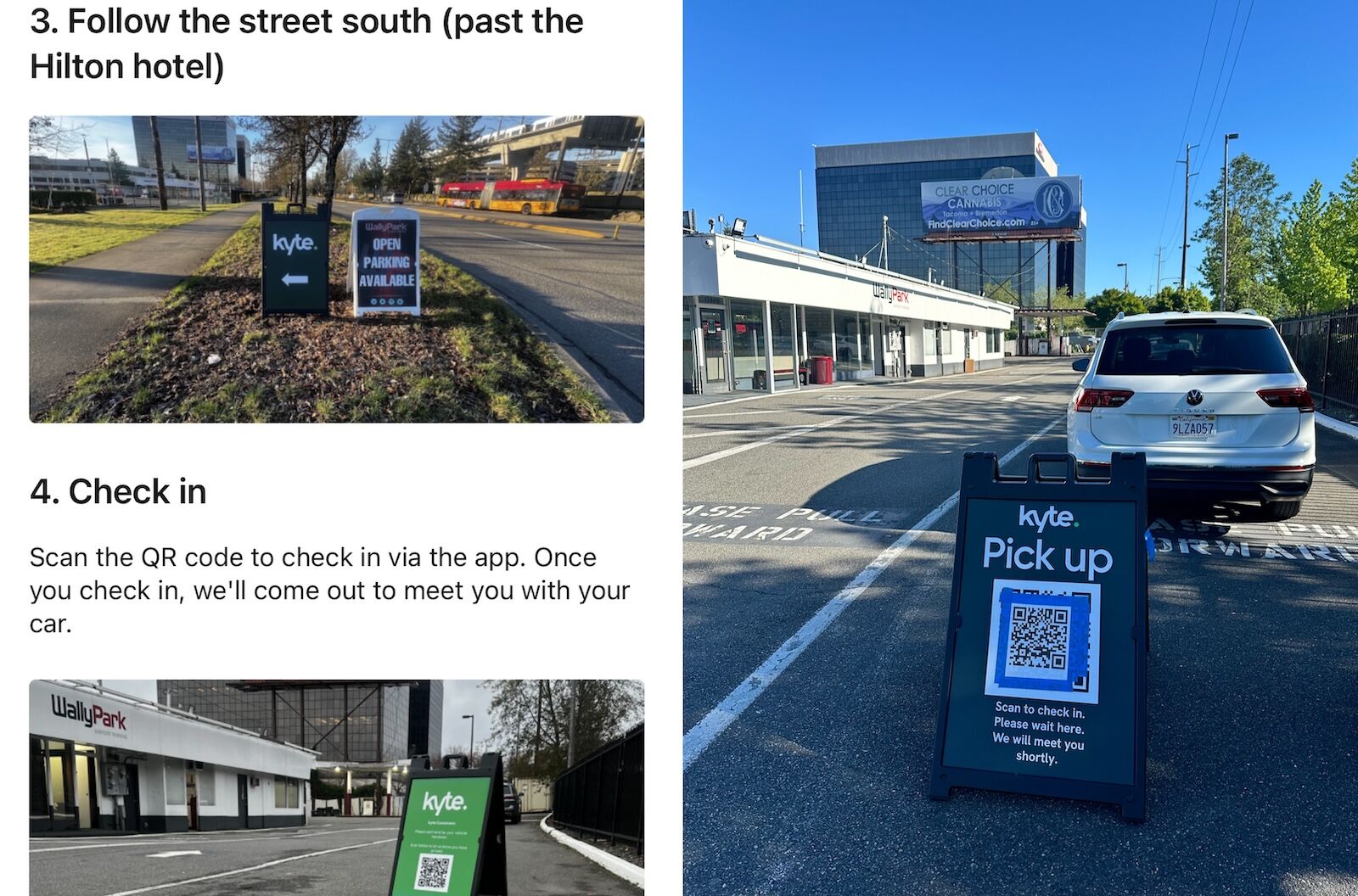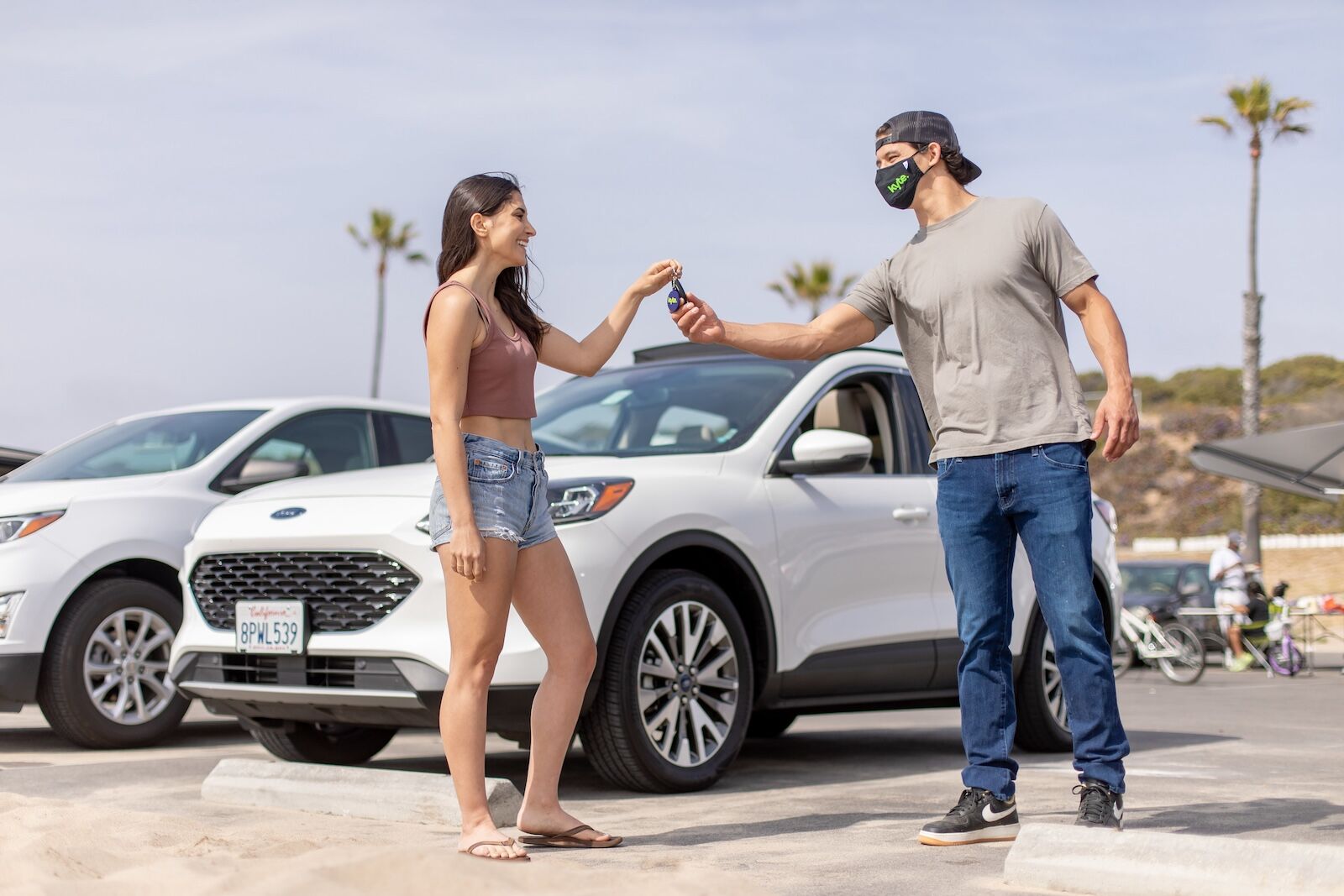Waiting in a rental car line is high on my list of things I try to avoid after a flight. This was confirmed on a recent trip to Washington when I saw hectic crowds squeezing around the construction at Seattle-Tacoma International Airport. This time around, I avoided them all with Kyte, a rental car company started in 2020 that delivers cars right to you or offers pick-ups and drop-offs at lots near select airports.


Tested: How Kyte Is Making the Often Frustrating Car Rental Process More Seamless
I rarely rented a car on my travels before I became a dad in late 2022, either for my frequent work trips as a travel writer and editor or for my own personal trips. I always packed light, and kept my schedule flexible to accommodate whatever public transportation had to offer (which often also meant a fair bit of walking). Traveling with a kid comes with a lot of literal baggage that’s not public transportation friendly. Another benefit? It opens the door to more easily explore rural areas around the cities I visit most.
The concept of Kyte will be familiar to anyone who has used any of the app-enabled services that have popped up over the last decade and a half: minimum human interaction (about 10 minutes with someone to check in and drop off a car, zero interaction with other people using the service); booking, verification, and alerts all handled immediately through an app; and often lower rates than the old way of doing things.
It does differ in a significant way from the Ubers and Airbnbs of the world, however. Kyte is not a peer-to-peer service that’s part of the “sharing economy.” Kyte owns all of its vehicles through a fleet provider, and professionally maintains the cars for the up to two years the company uses them.
“I previously worked at Uber and saw that people were always in search of convenience when it came to traveling,” Kyte cofounder Nikolaus Volk says in an email. “No one wants to wait in lines or be waiting for a driver. There were only these outdated methods when it came to renting a car and that always involved going to the airport or car rental storefront. There wasn’t an option to get a car for those short trips (and one that comes to your doorstep), and that’s where we started to design the model from.”
Kyte started during the pandemic, and only operates in a select set of cities. That limits use to people traveling to or using 12 major cities as a base where they can pick up or drop off their rental. More metro areas in the United States, as well as international, are set to be announced in 2025 as growth continues, Volk says. It’s important to note that currently cars are only available for use in the US. Users are responsible for the full cost of anything that happens if a vehicle is taken into Canada or Mexico.
Kyte is available in the following markets as of mid-2024:
- Atlanta
- Boston
- Brooklyn
- Chicago
- Denver
- Jersey City
- Los Angeles
- New York City
- Philadelphia
- San Francisco
- Seattle
- Washington, DC
Getting set up with Kyte
It’d be hard to argue that the days of glitchy and unusable apps are completely over. Yet we are living at a time when certain companies have taken all of the frustrations out of booking and arranging travel over an app through better tech and better design. Kyte is on a higher level than most, with a user experience on par with the ease of the award-winning United Airlines app.
I was able to submit my license, photo verification, credit card, and other information on the Kyte app even with spotty service from an Airbnb in Sitka, Alaska. The whole process, from download to booking confirmation, took about 15 minutes.
The cost of renting a car through Kyte
Rental cars are also expensive. A NerdWallet analysis of more than 480 rental car prices in 2024 found that the record high costs from July 2021 have abated, but every month in the first half of 2024 had a higher rental car price than any time before the pandemic — an average of 35 percent more, to be exact.
By NerdWallet’s numbers, the average seven-day car rental from Seattle-Tacoma Airport in 2024 is $690.60. The price we saw when booking our trip through an online travel company that compared costs from various brands in mid-July was more than $800 for six days, and that included savings from booking the car and flight together months ahead of time. We weren’t able to guarantee a vehicle big enough for myself, my wife, our toddler and her car seat, and our nanny (not to mention all those bags). While we were told an upgrade could be made at pick-up if a larger car was available, we could only be confirmed for a Ford Mustang — a two-door car with a decent trunk, but not ideal if we wanted any sort of comfort and space, regardless of how much I wanted my daughter to experience the joys of driving with the top down.
The options on Kyte couldn’t be more different. After registering, I booked an SUV with plenty of space in about 10 minutes just three days before we arrived in Seattle. The rental itself was $497.94, with an airport fee of $122.96. SUV damage insurance added another $114, and I added optional liability insurance for $119.94 (renters can skip this if their credit card insurance is sufficient). The total of $854.84 was about the same as our prior discounted booking, but only because I was able to secure extra insurance and a guaranteed vehicle type. Both of those things weren’t yet calculated into the price we would have seen if we went forward with our previous arrangement. By contrast, Kyte’s pricing is transparent before completing a reservation.
“Kyte fundamentally takes cost out of the operating model by getting rid of branches, staff and physical real estate,” Volk says, adding that “the primary guiding factor behind Kyte is to design the experience around the consumer. Our goal is to make it convenient, accessible and reliable. This also involves full transparency about fees, costs, insurance, etc.”
There are a lot of cost variables with travel, and car rentals are no exception. I highly suggest checking the price on Kyte before committing to any one service, as in my experience there was greater price transparency, more guarantees, and an overall comparable or lower rate.
Picking up and dropping off a Kyte rental car

Photo: Nickolaus Hines
The biggest differentiator is the straight-to-you delivery model that Kyte started with. A representative, called a Kyte Surfer, will drop off or pick up the vehicle in a 10-minute window of the designated time set when booking. There’s a $10 late fee outside of the grace period up to 30 minutes, or a $25 rescheduling fee outside of that time frame to compensate the Surfer for their time.
Kyte accounts for the sometimes unpredictable nature of travel with an easy method to update your times through the app up to two hours before the originally scheduled time for free. You can easily extend your rental through the app or shorten it for free more than 48 hours of the original drop-off (you’ll get a Kyte credit for the unused days if it’s less than 48 hours).
Both of the Surfers I interacted with were professional, timely, and seemed just as interested in making small talk as I was (meaning zero interest). Avoiding the back-and-forth upselling tactics I’ve experienced at every traditional car rental pick-up desk is reason enough to choose the service, in my opinion.
Kyte has expanded into select pick-up and drop-off locations since its launch — a crucial addition for people arriving at the airport and needing a vehicle immediately. While that makes it more similar to a standard car rental, there are still some clear advantages. Kyte’s locations aren’t in the hustle and bustle of the airport car rental center, so no waiting in line in close proximity to a bunch of people very tired of being crammed into close quarters after their flight. There’s also a bigger two-hour window for pick-ups and drop-offs.

Photo: Nickolaus Hines
That does mean some walking, however. At the Seattle airport, the pick up spot is at a lot that’s about a 15-minute walk from the terminals. The app provides clear walking instructions and helpful pictures to get there, but I did have to leave my bags with my wife at the terminal to avoid carrying our stuff, our toddler, and the many things that come with traveling with a toddler through the 90-degree summer heat. On the return, it meant dropping them off with our stuff before returning the car and meeting back up in the airport.
“Admittedly, Kyte is only carefully rolling out its service to airport locations in the country for exactly those reasons,” Volk explains. “We are doing a lot of diligence on customer experience, locations, etc. before launching new airports.”
The only other notable disadvantage for travelers is the need for a hand-off with a Surfer. While convenient during normal business hours, there’s no option for people taking a red-eye and no way to leave the car somewhere after hours. A little prior planning gets around that issue, though, as users can arrange for a car hand-off at their accommodations the day before they leave — even if they used a designated airport location for the pick-up.
Comparing Kyte to other rental car alternatives

Photo: Kyte
I’ve experimented with other car rentals outside of the traditional companies with mixed results. Turo, which takes the sharing economy concept of Airbnb and applies it to cars, has been one go-to, but has it’s downsides.
For one, renters are using someone’s daily car, so there’s always a more lived-in feel — and an owner who has very specific thoughts about how their vehicle is used. When my wife booked a Turo for a bachelorette party, the owner informed her that he had an Apple AirTag in the car for his own peace of mind and to be able to quickly find the car if there were any issues. Aside from the creepiness factor, that created an obvious safety issue for a group of women who were then forced to share their location on every drive with an unknown man, as well as alerting the owner to their Airbnb’s address and when they were likely there. There’s no guarantee that a Turo renter will get that same disclosure, and the possibility of the same thing happening again without being told ahead of time has always been in the back of our minds.
Some things with Kyte are standard for the rental car industry. There’s a mileage limit of 300 miles per day, calculated as the total number of days times 300. It’s 45 cents per mile after that, or you can opt for unlimited mileage for $15 per day during booking on the app or ahead of your trip with the help of a customer service agent. You can fill the tank back up yourself or pay for a small refueling fee similar to other car rental options. The minimum age for a driver is 21 (it’s free to add another driver) in all states but New York, where it’s 18, and there’s the typical young renter fee for drivers under 25.
The biggest advantage I found was the reliability of what you’re going to get. There’s no ambiguity or random upgrades or downgrades: what you book is what you receive. Full-size SUVs have seven seats, all economy cars on Kyte are four-door, and AWD options handle inclement weather. The luxury option is an Audi Q3, and for those who want to go electric there’s a standard option (Chevrolet Bolt) or premium (Tesla Model 3). The car models in each of Kyte’s eight vehicle classes are clearly laid out on the website.
Then there’s the customer support. I’ve spent hours on hold with car rental companies only to be hung up on. Thankfully, I didn’t have any issues when using Kyte. If I did, the response would be near immediate.
“We have an incredible Customer experience and customer support team who can help in any situation,” Volk says. “You can reach them via the in-app chat very quickly and they can also hop on the phone if there are issues. Our response times are usually in less than 30 seconds so you don’t have to worry about being stuck on a line for hours with other players. We want our customers to feel taken care of at each point in time.”